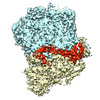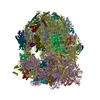[English] 日本語
 Yorodumi
Yorodumi- EMDB-2422: Molecular architecture of the 80S-eIF5B-Met-itRNAMet Eukaryotic T... -
+ Open data
Open data
- Basic information
Basic information
| Entry | Database: EMDB / ID: EMD-2422 | |||||||||
|---|---|---|---|---|---|---|---|---|---|---|
| Title | Molecular architecture of the 80S-eIF5B-Met-itRNAMet Eukaryotic Translation Initiation Complex | |||||||||
 Map data Map data | Reconstruction of 80S-eIF5B-Met-itRNAMet Eukaryotic Translation Initiation Complex with tRNA in the P/I-site and density for all four domains of eIF5B. | |||||||||
 Sample Sample |
| |||||||||
 Keywords Keywords | Ribosome initiation complex / initiator factor eiF5B / cryo EM / single particle analysis | |||||||||
| Function / homology |  Function and homology information Function and homology informationtriplex DNA binding / ribosome hibernation / translation elongation factor binding / regulation of translational initiation in response to stress / Platelet degranulation / protein-synthesizing GTPase / maturation of SSU-rRNA from tricistronic rRNA transcript (SSU-rRNA, LSU-rRNA,5S) / formation of cytoplasmic translation initiation complex / eukaryotic 48S preinitiation complex / negative regulation of glucose mediated signaling pathway ...triplex DNA binding / ribosome hibernation / translation elongation factor binding / regulation of translational initiation in response to stress / Platelet degranulation / protein-synthesizing GTPase / maturation of SSU-rRNA from tricistronic rRNA transcript (SSU-rRNA, LSU-rRNA,5S) / formation of cytoplasmic translation initiation complex / eukaryotic 48S preinitiation complex / negative regulation of glucose mediated signaling pathway / negative regulation of translational frameshifting / Negative regulators of DDX58/IFIH1 signaling / positive regulation of translational fidelity / Protein methylation / RMTs methylate histone arginines / mTORC1-mediated signalling / Protein hydroxylation / ribosome-associated ubiquitin-dependent protein catabolic process / GDP-dissociation inhibitor activity / regulation of translational initiation / positive regulation of nuclear-transcribed mRNA catabolic process, deadenylation-dependent decay / pre-mRNA 5'-splice site binding / Formation of the ternary complex, and subsequently, the 43S complex / Translation initiation complex formation / Ribosomal scanning and start codon recognition / translational elongation / cleavage in ITS2 between 5.8S rRNA and LSU-rRNA of tricistronic rRNA transcript (SSU-rRNA, 5.8S rRNA, LSU-rRNA) / preribosome, small subunit precursor / response to cycloheximide / telomeric DNA binding / mRNA destabilization / Major pathway of rRNA processing in the nucleolus and cytosol / SRP-dependent cotranslational protein targeting to membrane / GTP hydrolysis and joining of the 60S ribosomal subunit / Formation of a pool of free 40S subunits / Nonsense Mediated Decay (NMD) independent of the Exon Junction Complex (EJC) / Nonsense Mediated Decay (NMD) enhanced by the Exon Junction Complex (EJC) / negative regulation of mRNA splicing, via spliceosome / L13a-mediated translational silencing of Ceruloplasmin expression / preribosome, large subunit precursor / ribosomal large subunit export from nucleus / endonucleolytic cleavage to generate mature 3'-end of SSU-rRNA from (SSU-rRNA, 5.8S rRNA, LSU-rRNA) / G-protein alpha-subunit binding / TOR signaling / positive regulation of protein kinase activity / protein-RNA complex assembly / regulation of translational fidelity / Ub-specific processing proteases / ribosomal small subunit export from nucleus / translation regulator activity / ribosomal subunit export from nucleus / translational termination / endonucleolytic cleavage in ITS1 to separate SSU-rRNA from 5.8S rRNA and LSU-rRNA from tricistronic rRNA transcript (SSU-rRNA, 5.8S rRNA, LSU-rRNA) / translation repressor activity / DNA-(apurinic or apyrimidinic site) endonuclease activity / translation initiation factor binding / translational initiation / translation initiation factor activity / cellular response to amino acid starvation / ribosome assembly / telomere maintenance / rescue of stalled ribosome / maturation of LSU-rRNA from tricistronic rRNA transcript (SSU-rRNA, 5.8S rRNA, LSU-rRNA) / 90S preribosome / maturation of SSU-rRNA from tricistronic rRNA transcript (SSU-rRNA, 5.8S rRNA, LSU-rRNA) / cytosolic ribosome assembly / maturation of LSU-rRNA / ribosomal large subunit biogenesis / maturation of SSU-rRNA / small-subunit processome / positive regulation of apoptotic signaling pathway / protein kinase C binding / maintenance of translational fidelity / ribosomal large subunit assembly / cytoplasmic stress granule / modification-dependent protein catabolic process / rRNA processing / protein tag activity / ribosome biogenesis / ribosome binding / ribosomal small subunit biogenesis / ribosomal small subunit assembly / small ribosomal subunit / small ribosomal subunit rRNA binding / 5S rRNA binding / large ribosomal subunit rRNA binding / cytosolic small ribosomal subunit / cytosolic large ribosomal subunit / cytoplasmic translation / rRNA binding / negative regulation of translation / ribosome / protein ubiquitination / structural constituent of ribosome / translation / positive regulation of protein phosphorylation / G protein-coupled receptor signaling pathway / negative regulation of gene expression / response to antibiotic / GTPase activity Similarity search - Function | |||||||||
| Biological species |  | |||||||||
| Method | single particle reconstruction / cryo EM / negative staining / Resolution: 6.6 Å | |||||||||
 Authors Authors | Fernandez IS / Bai XC / Hussain T / Kelley AC / Lorsch JR / Ramakrishnan V / Scheres SHW | |||||||||
 Citation Citation |  Journal: Science / Year: 2013 Journal: Science / Year: 2013Title: Molecular architecture of a eukaryotic translational initiation complex. Authors: Israel S Fernández / Xiao-Chen Bai / Tanweer Hussain / Ann C Kelley / Jon R Lorsch / V Ramakrishnan / Sjors H W Scheres /   Abstract: The last step in eukaryotic translational initiation involves the joining of the large and small subunits of the ribosome, with initiator transfer RNA (Met-tRNA(i)(Met)) positioned over the start ...The last step in eukaryotic translational initiation involves the joining of the large and small subunits of the ribosome, with initiator transfer RNA (Met-tRNA(i)(Met)) positioned over the start codon of messenger RNA in the P site. This step is catalyzed by initiation factor eIF5B. We used recent advances in cryo-electron microscopy (cryo-EM) to determine a structure of the eIF5B initiation complex to 6.6 angstrom resolution from <3% of the population, comprising just 5143 particles. The structure reveals conformational changes in eIF5B, initiator tRNA, and the ribosome that provide insights into the role of eIF5B in translational initiation. The relatively high resolution obtained from such a small fraction of a heterogeneous sample suggests a general approach for characterizing the structure of other dynamic or transient biological complexes. | |||||||||
| History |
|
- Structure visualization
Structure visualization
| Movie |
 Movie viewer Movie viewer |
|---|---|
| Structure viewer | EM map:  SurfView SurfView Molmil Molmil Jmol/JSmol Jmol/JSmol |
| Supplemental images |
- Downloads & links
Downloads & links
-EMDB archive
| Map data |  emd_2422.map.gz emd_2422.map.gz | 49.3 MB |  EMDB map data format EMDB map data format | |
|---|---|---|---|---|
| Header (meta data) |  emd-2422-v30.xml emd-2422-v30.xml emd-2422.xml emd-2422.xml | 11.1 KB 11.1 KB | Display Display |  EMDB header EMDB header |
| Images |  EMD-2422.jpg EMD-2422.jpg | 116.7 KB | ||
| Archive directory |  http://ftp.pdbj.org/pub/emdb/structures/EMD-2422 http://ftp.pdbj.org/pub/emdb/structures/EMD-2422 ftp://ftp.pdbj.org/pub/emdb/structures/EMD-2422 ftp://ftp.pdbj.org/pub/emdb/structures/EMD-2422 | HTTPS FTP |
-Validation report
| Summary document |  emd_2422_validation.pdf.gz emd_2422_validation.pdf.gz | 303.5 KB | Display |  EMDB validaton report EMDB validaton report |
|---|---|---|---|---|
| Full document |  emd_2422_full_validation.pdf.gz emd_2422_full_validation.pdf.gz | 302.7 KB | Display | |
| Data in XML |  emd_2422_validation.xml.gz emd_2422_validation.xml.gz | 6 KB | Display | |
| Arichive directory |  https://ftp.pdbj.org/pub/emdb/validation_reports/EMD-2422 https://ftp.pdbj.org/pub/emdb/validation_reports/EMD-2422 ftp://ftp.pdbj.org/pub/emdb/validation_reports/EMD-2422 ftp://ftp.pdbj.org/pub/emdb/validation_reports/EMD-2422 | HTTPS FTP |
-Related structure data
| Related structure data |  4v8zMC  2421C  4v8yC C: citing same article ( M: atomic model generated by this map |
|---|---|
| Similar structure data |
- Links
Links
| EMDB pages |  EMDB (EBI/PDBe) / EMDB (EBI/PDBe) /  EMDataResource EMDataResource |
|---|---|
| Related items in Molecule of the Month |
- Map
Map
| File |  Download / File: emd_2422.map.gz / Format: CCP4 / Size: 51.5 MB / Type: IMAGE STORED AS FLOATING POINT NUMBER (4 BYTES) Download / File: emd_2422.map.gz / Format: CCP4 / Size: 51.5 MB / Type: IMAGE STORED AS FLOATING POINT NUMBER (4 BYTES) | ||||||||||||||||||||||||||||||||||||||||||||||||||||||||||||||||||||
|---|---|---|---|---|---|---|---|---|---|---|---|---|---|---|---|---|---|---|---|---|---|---|---|---|---|---|---|---|---|---|---|---|---|---|---|---|---|---|---|---|---|---|---|---|---|---|---|---|---|---|---|---|---|---|---|---|---|---|---|---|---|---|---|---|---|---|---|---|---|
| Annotation | Reconstruction of 80S-eIF5B-Met-itRNAMet Eukaryotic Translation Initiation Complex with tRNA in the P/I-site and density for all four domains of eIF5B. | ||||||||||||||||||||||||||||||||||||||||||||||||||||||||||||||||||||
| Voxel size | X=Y=Z: 1.77 Å | ||||||||||||||||||||||||||||||||||||||||||||||||||||||||||||||||||||
| Density |
| ||||||||||||||||||||||||||||||||||||||||||||||||||||||||||||||||||||
| Symmetry | Space group: 1 | ||||||||||||||||||||||||||||||||||||||||||||||||||||||||||||||||||||
| Details | EMDB XML:
CCP4 map header:
| ||||||||||||||||||||||||||||||||||||||||||||||||||||||||||||||||||||
-Supplemental data
- Sample components
Sample components
-Entire : Reconstruction of 80S-eIF5B-Met-itRNAMet Eukaryotic Translation I...
| Entire | Name: Reconstruction of 80S-eIF5B-Met-itRNAMet Eukaryotic Translation Initiation Complex with tRNA in the P/I-site and density for all four domains of eIF5B. |
|---|---|
| Components |
|
-Supramolecule #1000: Reconstruction of 80S-eIF5B-Met-itRNAMet Eukaryotic Translation I...
| Supramolecule | Name: Reconstruction of 80S-eIF5B-Met-itRNAMet Eukaryotic Translation Initiation Complex with tRNA in the P/I-site and density for all four domains of eIF5B. type: sample / ID: 1000 / Number unique components: 2 |
|---|---|
| Molecular weight | Experimental: 4.2 MDa / Theoretical: 4.2 MDa |
-Supramolecule #1: 80S-Met-itRNAMet Eukaryotic Translation Initiation Complex
| Supramolecule | Name: 80S-Met-itRNAMet Eukaryotic Translation Initiation Complex type: complex / ID: 1 / Recombinant expression: No / Ribosome-details: ribosome-eukaryote: ALL |
|---|---|
| Source (natural) | Organism:  |
| Molecular weight | Experimental: 4.2 MDa / Theoretical: 4.2 MDa |
-Macromolecule #1: eiF5B
| Macromolecule | Name: eiF5B / type: protein_or_peptide / ID: 1 / Recombinant expression: Yes |
|---|---|
| Source (natural) | Organism:  |
| Recombinant expression | Organism:  |
-Experimental details
-Structure determination
| Method | negative staining, cryo EM |
|---|---|
 Processing Processing | single particle reconstruction |
| Aggregation state | particle |
- Sample preparation
Sample preparation
| Concentration | 0.3 mg/mL |
|---|---|
| Buffer | pH: 7.2 Details: 3mM Hepes-KOH, 6.6 mM Tris-acetate pH 7.2, 3 mM NH4Cl, 6.6 mM NH4-acetate, 48 mM K-acetate, 4 mM Mg-acetate, 2.4 mM DTT |
| Staining | Type: NEGATIVE / Details: cryo-EM |
| Grid | Details: Quantifoil grids (2/2) with 3 nm thin carbon on top |
| Vitrification | Cryogen name: ETHANE / Chamber humidity: 100 % / Chamber temperature: 90 K / Instrument: FEI VITROBOT MARK II / Method: Blot 2.5 seconds before plunging |
- Electron microscopy
Electron microscopy
| Microscope | FEI POLARA 300 |
|---|---|
| Temperature | Min: 80 K / Max: 90 K / Average: 85 K |
| Alignment procedure | Legacy - Astigmatism: Objective lens astigmatism was corrected at 59,000 times magnification |
| Date | Jan 15, 2013 |
| Image recording | Category: CCD / Film or detector model: FEI FALCON I (4k x 4k) / Digitization - Sampling interval: 14 µm / Number real images: 1012 / Average electron dose: 16 e/Å2 Details: Every image is the average of 16 frames recorded by the direct electron detector |
| Electron beam | Acceleration voltage: 300 kV / Electron source:  FIELD EMISSION GUN FIELD EMISSION GUN |
| Electron optics | Calibrated magnification: 79096 / Illumination mode: FLOOD BEAM / Imaging mode: BRIGHT FIELD / Cs: 2 mm / Nominal defocus max: 3.9 µm / Nominal defocus min: 1.9 µm / Nominal magnification: 59000 |
| Sample stage | Specimen holder model: GATAN LIQUID NITROGEN |
| Experimental equipment |  Model: Tecnai Polara / Image courtesy: FEI Company |
- Image processing
Image processing
| Details | Use a newly developed statistical movie processing approach to compensate for beam-induced movement. Use a newly developed statistical movie processing to compensate for beam-induced movement. |
|---|---|
| CTF correction | Details: Each particle |
| Final reconstruction | Applied symmetry - Point group: C1 (asymmetric) / Resolution.type: BY AUTHOR / Resolution: 6.6 Å / Resolution method: OTHER / Software - Name: CTFFIND3, RELION Details: Use a newly developed statistical movie processing approach to compensate for beam-induced movement. Number images used: 5143 |
 Movie
Movie Controller
Controller



























